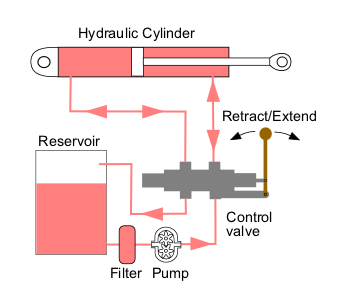What is Hydraulics and Hydraulic components
Hydraulics has been derived from 2 Greek words that are: ‘Hydor’ which means water and ‘Aulus’ which means pipe. So in simple terms, we can say that hydraulic can be defined as the work done by the fluids in the pipes.

Hydraulic is one of the main sources of power transmission in modern equipment and machinery. In the hydraulic system, we must understand that mechanical energy gets converted into hydraulic energy and that energy is then converted back to mechanical energy.
Hydraulics is based on the Pascal law.
What is Pascal’s Law?
According to Pascal’s law, any force applied to a confined fluid, then this force is transmitted uniformly in all directions throughout the fluid regardless of the shape of the container.
Mathematically, Pascal’s law can be defined as the force per unit area.
P = F/A
Where ‘P’ is the pressure in kilogram per centimeter square (kg/cm2)
‘A’ is an area in square centimeters (cm2)
‘F’ is the force in kilograms (kgf)
Components of a Hydraulic System
Hydraulic System consists of many components and we will be describing them one by one.
Hydraulic Pump
A hydraulic pump is the heart of the hydraulic system. It generates flow in the hydraulic circuit. A hydraulic pump is used to take the oil from the reservoir and deliver it to the system. There are many types of pumps like vane pumps, gear pumps, piston pumps, etc.
Prime Mover
Then there is a prime mover which is generally an electrical motor or engine which drives the pump.
Pressure Control Valve
Pressure control valves are generally found in all hydraulic and pneumatic circuits. These valves are used to maintain the pressure of a system. Without these valves, there are high chances of an accident and the whole system may fail.
Flow Control Valve
Flow control valves are used in the hydraulic system which is needed to control the speed of the actuators like server motors or cylinders. Flow control valves regulate the flow of a fluid.
Direction Control Valves
Direction control valves start, stop or change the direction of the flow in a hydraulic circuit. These valves are necessary to perform some tasks in either direction.
Accessories
There are accessories in the hydraulic system to enhance the performance of this system. There are many accessories like strainers, filters, pressure gauges, accumulators, temperature gauges, etc.
Suction Strainers
A suction strainer is a strainer that is mounted on the suction line of a pump and helps to trap the contaminants going into the pump, thus in the system. It generally gets chock if the oil is not cleaned. It should be cleaned regularly or changed at a specific interval of time.
Return Line Filter
The return line filter is mounted on the return line of the system. It allows the clean oil to travel back to the pump by trapping the contaminants which generate in the system while running.
Pressure Gauge
A pressure gauge in a hydraulic system indicates the pressure at a given point in a hydraulic line.
Breather Filter
The breather filter is mounted on the top plate of the hydraulic tank. The main function of the breather filter is to allow the reservoir to breathe in i.e when the hydraulic oil goes into the circuit with the help of a pump, then the air rushes in to fill that gap vacated by oil and when oil comes back to the reservoir, then the air goes out from breather filter.
This is also used to fill the oil in the reservoir.
Temperature gauge
A temperature gauge is mounted on the tank and is used to measure the temperature of the oil as it is required to maintain the temperature.
Actuators
Actuators are generally hydraulic cylinder or hydraulic motors which gives movement or do the actual work in the system.
Accumulator
An accumulator in a hydraulic system is a pressure vessel in which an incompressible fluid is kept under the pressure. There are different kinds of accumulators which include piston, diaphragm, and bladder accumulators.
Application of Hydraulics
Hydraulics is used in the following industries:
- Foundry
- Automobile
- Agriculture
- Aviation
- Defense
- HVAC
- Machine Tools
- Instrumentation
- Material Handling
- Medical
- Mining
- Paper Industry
- Robots
- Transportation
- Textiles
- Oil Industry
- Printing
- Food Industry etc.
Frequently Asked Questions
What is the hydraulics?
Hydraulics has been derived from 2 Greek words that are: ‘Hydor’ which means water and ‘Aulus’ which means pipe. So in simple terms, we can say that hydraulic can be defined as the work done by the fluids in the pipes.
What are examples of hydraulics?
Hydraulics are used in many industries, including cranes, hydra, hydraulic brakes and in airplanes, etc.
What is Pascal Law?
According to Pascal’s law, any force applied to a confined fluid, then this force is transmitted uniformly in all directions throughout the fluid regardless of the shape of the container.
How do you stop a hydraulic cylinder from leaking?
The hydraulic cylinder can be stopped from leaking in the following ways:
1.) Maintain the rod seal.
2.) Piston rod should be aligned and not bent.
3.) Fluid contamination should not be there.
4.) Temperature of oil to be controlled.
Also, Read about Types of Gears
